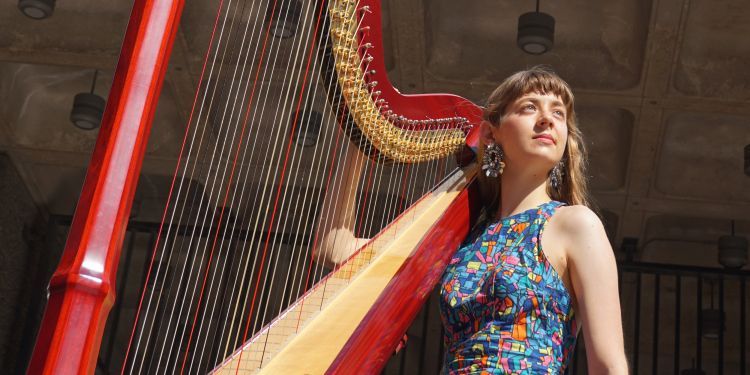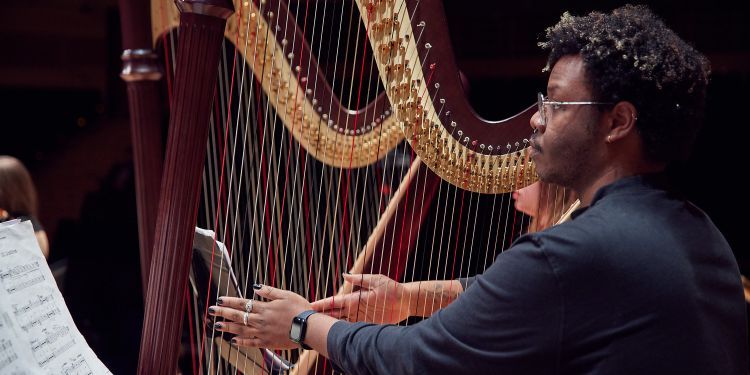
Breadcrumb navigation
Harp Studies
The dynamic Harp Department at the Guildhall School of Music & Drama combines teaching of the highest calibre with a stimulating and extensive harp course, designed to give students all the skills they need to be confident, versatile professional musicians.

About Harp Studies at Guildhall
The dynamic Harp Department at Guildhall School of Music & Drama combines teaching of the highest calibre with a stimulating and extensive harp course, designed to give students all the skills they need to be confident, versatile professional musicians. Enjoying an unrivalled position in the heart of the City of London, the Guildhall offers harpists the chance to study in the music capital of the world.
Imogen Barford, Head of Harp, leads a team of distinguished professional harpists, including Charlotte Seale, Bryn Lewis, Helen Tunstall, Keziah Thomas, Lucy Wakeford, Monika Stadler and Joy Smith, each with individual areas of expertise. Their work in regular classes, masterclasses and workshops covers every aspect of harp-playing, and is enhanced by visits from guest harpists pre-eminent in the UK and abroad.
Find out more about studying harp at Guildhall with this Course Overview video, created by the Harp department.
About Harp Studies at Guildhall
Individual Tuition
Individual teaching is at the heart of the department, giving students the space and support to focus seriously and thoughtfully on every aspect of technique and musicianship. The teacher and student work intensively to discover the easiest and most natural way of playing for each individual hand shape, allowing the student fully to realise their technical, musical and creative potential.
One-to-one weekly lessons on modern harp are given by Imogen Barford, Charlotte Seale and Keziah Thomas; advanced students can take hours with Bryn Lewis, Helen Tunstall and Lucy Wakeford. Individual lessons on early harps are given by Joy Smith.
Classes
All harp students take part in regular performance classes. These cover aspects of performance, airing of work-in-progress, group feedback and learning to listen and help one another constructively.
These are given by harp department staff and visiting experts:
Orchestral Studies (given by Bryn Lewis, Principal Harp, London Symphony Orchestra)
Core repertoire, cadenzas, preparing parts, speed learning, playing in the orchestra and orchestral etiquette. Harpists benefit from formal links with the London Symphony Orchestra harp section, next door at the Barbican Centre, weekly repertoire sessions with the Wind, Brass and Percussion department, and sit-in opportunities with the London Symphony Orchestra.
Teaching Skills
All aspects of teaching the harp, including observing teachers.
Chamber Music
Thorough study and coaching of major works.
Contemporary Musicianship (given by Helen Tunstall, Principal Harp of the London Sinfonietta)
Practical Harmony, Jazz and Improvisation (given by Austrian Jazz harpist Monika Stadler)
Repertoire
Providing wide knowledge of the principal works in each genre, with particular regard to programme planning.
Career Planning in the Digital Age (taught by Keziah Thomas)
Social media content creation, filming, editing, recording, speaking to camera, networking
Enhanced Skills
Advanced technique
How to practise
Sight-reading, Memorising
Glissandi and Trills
Given by harp department staff and visiting experts, including:
History of the harp, introduction to early harps
Major works in context
How to get work: presentation, CVs, brochures
Creative career planning
Creative programme planning
Given regularly by distinguished visiting musicians from the UK and abroad. These have included:
- Marie-Pierre Langlamet (France/Germany)
- Sylvain Blassel (France)
- Catherine Michel (France)
- Nancy Allen (US)
- Isabelle Perrin (France)
- Anneleen Lenaerts (Belgium/Austria)
- Alice Giles (Australia)
- Erika Waardenburg (The Netherlands)
- Sivan Magen (Israel)
- Letizia Belmondo (Italy)
- Petra Van Der Heide (The Netherlands)
- Stephen Fitzpatrick
- Emily Hoile
- Park Stickney
- Masumi Nagasawa
- Gwyneth Wentink
Postgraduate and undergraduate students can take Early Harp as an option. Postgraduates can take Early Harp as a full or part-time programme; undergraduates can take it as a full-time programme, or as a second study; all harpists have opportunities to attend stylistic workshops with Joy Smith. All early harp options take place in collaboration with the Historical Performance Department.
Subjects taught include:
- Single row (Medieval and Gothic) harps
- Italian triple harp
- Handel and the Welsh triple harp
- Spanish cross-strung harp
- Continuo
- Irish wire-strung harps

Programmes
All Harp Studies form part of the Guildhall School’s main programmes, outlined below. There are also individualised programmes of study.
For more information, contact Imogen Barford.
Performance Opportunities and Venues
- Solo concerts
- symphony and chamber orchestras
- chamber ensembles
- harp ensemble
- new music and early music ensembles
- jazz orchestra, studio orchestra, film orchestra and big band
- termly opera productions, including Baroque operas, and summer musicals
- contemporary music ensembles and Ubu Ensemble
Venues include the Barbican Centre, St John’s Smith Square, LSO St Lukes, Wigmore Hall, the Museum of London, the National Portrait Gallery, the Wallace Collection, St George’s Hanover Square, St Giles Cripplegate, St Sepulchre’s, St Olave’s, HM Treasury, St Benet’s, Christ Church Spitalfields as well as the in-house Music Hall, Silk Street Theatre, Lecture Recital Room, and the fantastic facilities of Milton Court.
Facilities
Guildhall School owns a wide array of harps, with instruments from the Middle Ages to the latest electro-acoustic harp. There are ten pedal harps, plus access to an antique Gothic Erard and a single-action Erard.
The School also owns a Medieval harp, a Gothic Renaissance harp, a large Italian Baroque triple harp, and a Camac Blue electric harp. Students have exclusive use of the harp room for solo and group work, and another harp practice room is available in the Annexe.
The library has been extensively stocked with music, CDs and books, and harpists also have access to an enormous private library of solo, ensemble and orchestral parts.



